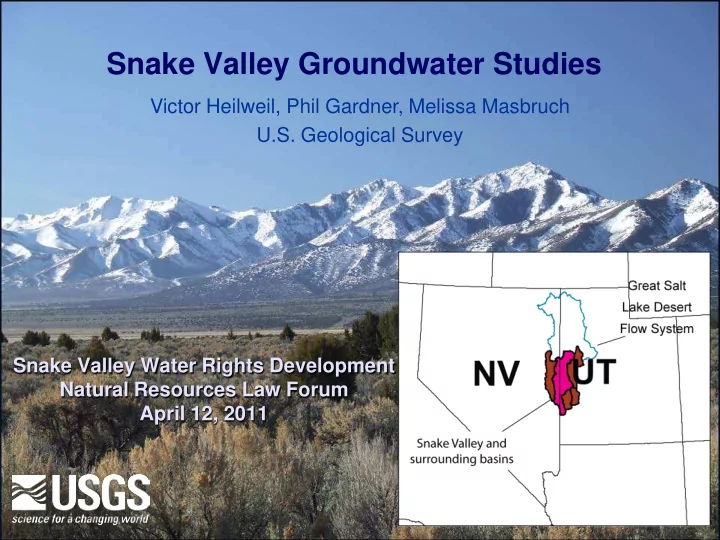

Snake Valley Groundwater Studies Victor Heilweil, Phil Gardner, Melissa Masbruch U.S. Geological Survey Snake Valley Water Rights Development Natural Resources Law Forum April 12, 2011
Conceptual model of groundwater budget
Well pumping Evapotranspiration Evapotranspiration Springs Forms of groundwater discharge
Likelihood of subsurface flow Snake Valley Fish Springs Flat
Preliminary Snake Valley Groundwater Budget Sub-surface Discharge Recharge outflow? Wells and springs Precipitation Evapo- transpiration Sub-surface inflow ?
Previous USGS groundwater budget estimates • Estimates of total recharge and discharge range from 100,000 to 160,000 acre-ft/yr (Heilweil and Brooks, eds, 2011) (Welch and others, eds, 2007) (Harrill and Prudic, 1988) (Gates and Kruer, 1981) (Hood and Rush, 1965)
Snake Valley groundwater budget Total Recharge Total Discharge 240,000 200,000 Acre-ft / year 160,000 120,000 80,000 ? 40,000 0 Tech Pub 14 Tech Pub 71 RASA (1988) BARCAS (2007) GBCAAS (2011) (1965) (1981) *pre-development and includes spring discharge
Groundwater Budget Concepts • UT/NV Snake Valley agreement depends on available groundwater supply (sustainable yield) • Sustainable yield is “the development of groundwater resources in a manner that can be maintained for an indefinite time without causing unacceptable consequences” (Alley and Leake, 2004) • Sustainable yield for Snake Valley is based on estimated natural discharge: 108,000 acre-ft/yr (80% of BARCAS discharge estimate) • Any additional groundwater development must come from a combination of increased recharge, water from storage (water-level declines), or captured natural discharge (springs or ET) (Bredehoeft, 2002)
UT/NV Snake Valley Agreement (Section 5.4) Agreement prohibits: • Ground-water mining • Impairment of water quality • Compaction of aquifers or surface instability
Potential mining/compaction effects Beryl-Enterprise pumping and water levels 120,000 40 100,000 Water level below land surface (feet) Withdrawal, acre-ft/yr 60 80,000 80 60,000 100 40,000 120 20,000 140 Subsidence cracks (Photo courtesy of Bill Lund, UGS) 160 0 1… 1… 1… 1… 1… 1… 1… 1… 1… 1… 1… 1… 1… 1… 1… 1… 1… 1… 1… 2… 2… 1946 1956 1966 1976 1986 1996 2006
Salt Lake Valley pumping and water levels 180,000 100 160,000 Water level below land surface (feet) 90 140,000 Withdrawal, acre-ft/yr 80 120,000 70 100,000 60 80,000 50 40 60,000 30 40,000 20 20,000 10 0 0 Impacts of additional pumping in Snake Valley will likely fall somewhere between these two end members
Approach: to improve knowledge of groundwater processes and refine groundwater budget (establishing the framework for future evaluation effects of additional pumping) • Spring & water-level monitoring (UGS, USGS, SNWA) • Well pumping (USGS) • Water chemistry and age (UGS, SNWA, USGS) • Groundwater modeling (SNWA, NPS, BLM, USGS)
UGS Groundwater Monitoring Network H. Hurlow, L. Jordan, M. Lowe, Utah Geological Survey http://geology.utah.gov/databases/gro undwater Monitoring well drilling Discharge measurements (Twin Springs)
SNWA/USGS Great Salt Lake Desert Water-level monitoring network: 76 monitoring wells measured quarterly
Potentiometric map • Contour water levels to generate map of the water level surface • Groundwater flow directions • Used to develop numerical models and interpret geochemistry
Historical pumping in Snake Valley
Geochemistry ( 3 H, 4 He, 14 C, noble gases) for determining groundwater flow paths and age
Numerical Model Model construction: • Model area > 8,000 mi 2
Model progress Model construction: • Model area > 8,000 mi 2 • Geology represent as 7 units B’ A A’ B
Numerical Model Model construction: • Model area > 8,000 mi 2 • Geology represent as 7 units • Recharge (200,000 acre-ft/yr)
Numerical Model Model construction: • Model area > 8,000 mi 2 • Geology represent as 7 units • Recharge (200,000 acre-ft/yr) • Discharge - ET (130,000 – 160,000 af/yr) - Springs (60,000 af/yr) - Pumping (18,000 af/yr) Model calibration: • Water levels from 130 wells
Numerical Model Model construction: • Model area > 8,000 mi 2 • Geology represent as 7 units • Recharge (205,000 acre-ft/yr) • Discharge - ET (130,000 – 160,000 af/yr) - Springs (60,000 af/yr) - Pumping (18,000 af/yr) Model calibration: • Water levels from 130 wells • Temperature logs from 23 wells
Summary Current studies and data collection focused on: • Baseline monitoring and variability • Understanding groundwater processes and flow paths • Reducing uncertainty in groundwater budget components Such information will ultimately improve accuracy of numerical groundwater models and ability to predict effects of future pumping
For Additional Information Phil Gardner, Snake Valley Project Chief US Geological Survey pgardner@usgs.gov http://ut.water.usgs.gov/projects/snake/ 801-908-5041 Hugh Hurlow, West Desert Monitoring Program Utah Geological Survey hughhurlow@utah.gov http://geology.utah.gov/databases/groundwater 801-537-3385
Snake Valley Groundwater Budget Comparison Recharge Sub- from Subsurface Total Evapotran Wells/ surface Total Study Precipitation Inflow Recharge spiration Springs Outflow Discharge Tech Pub 14 (1965) 100,000 4,000 104,000 95,000 7,000 10,000 112,000 Tech Pub 71 (1981) 102,000 4,000 106,000 64,000 18,000 42,000 124,000 RASA (1988) 100,000 4,000 104,000 -- -- 42,000 -- BARCAS (2007) 111,000 49,000 160,000 132,000* -- 29,000 161,000 160,000 ± 160,000± 100,000 ± 30,000 130,000± GBCAAS (2011) 80,000 ?? 80,000 25,000 ±7,500 ?? 30,000 * pre-development and includes spring discharge
Recommend
More recommend